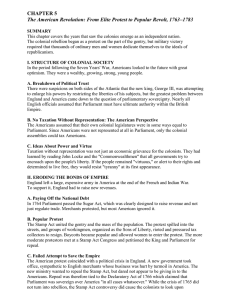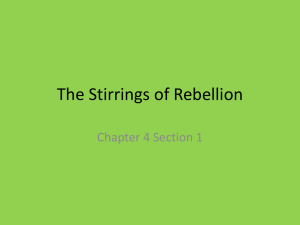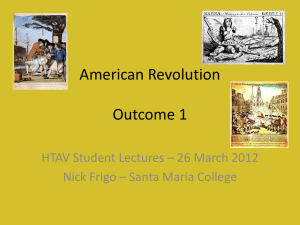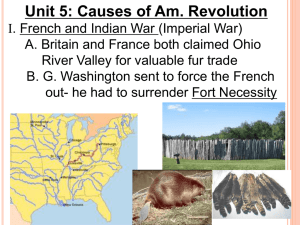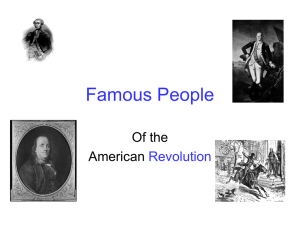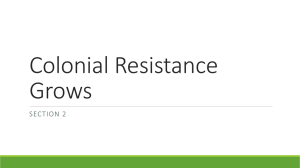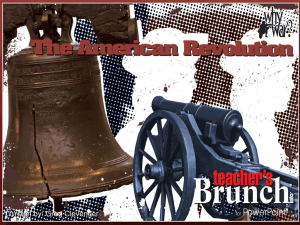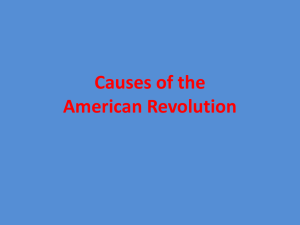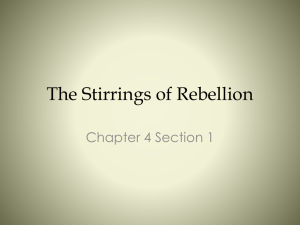THE AMERICAN REVOLUTION
advertisement
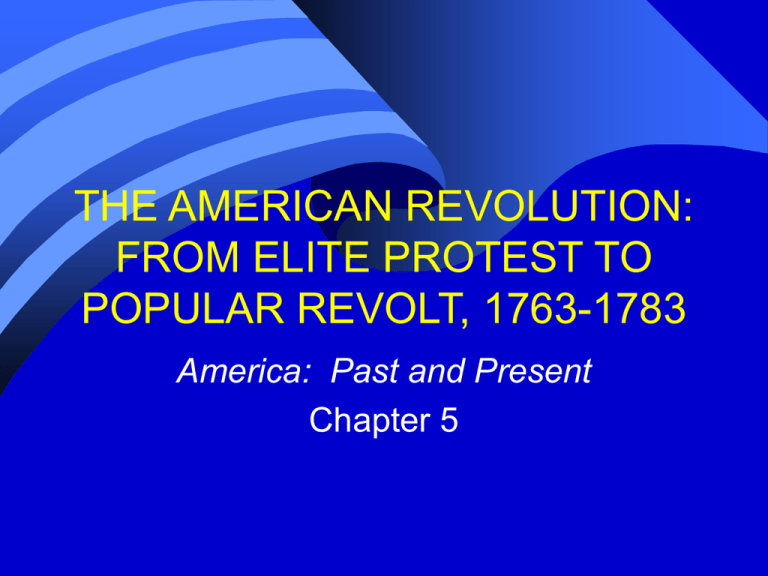
THE AMERICAN REVOLUTION: FROM ELITE PROTEST TO POPULAR REVOLT, 1763-1783 America: Past and Present Chapter 5 Structure of Colonial Society 1760s an optimistic post-war period – striking ethnic and racial diversity – 60% of population under 21 years old – high level of post-war prosperity – wealth unevenly distributed Americans proud to be part of Europe’s most thriving, prosperous empire Breakdown of Political Trust 1760--George III ascended throne Suspicions on both sides of the Atlantic that Crown wished to enlarge its powers Conflict over Parliamentary sovereignty – – English officials assumed that Parliament must have ultimate authority colonists tried to reserve internal colonial authority for their own legislatures No Taxation Without Representation: the American Perspective Colonists assume their legislatures equal in some ways to Parliament Americans not represented at all in Parliament British officials espoused “virtual representation” Colonists insist only colonial assemblies could tax Americans Ideas About Power and Virtue John Locke, "Commonwealthmen" inform colonial political thought All governments believed susceptible to corruption into “tyranny” – “tyranny” understood as any attempt to encroach upon the people's liberty “Virtuous” citizens, alert to rights and determined to live free, resist tyranny Eroding the Bonds of Empire Large, expensive army left in America at the end of the Seven Years’ War Colonists doubted the army’s value Pontiac’s War – exposed the British army’s weakness – revealed the desperate situation of Native Americans after withdrawal of French Colonists determined to settle transAppalachian West Paying off the National Debt First minister George Grenville attempts to reduce England’s war debt Revenue Act of 1764 (the Sugar Act) Merchants and gentry protest, most colonists ignore Colonial Products and Trade Popular Protest 1765--Stamp Act requires that colonists purchase stamp to validate documents Unites the gentry and the mass of the population in protest Stamp Act Congress petitions the King and Parliament for repeal Protest includes mob riots, boycotts Failed Attempts to Save the Empire 1766--New administration in office, favors repeal of Stamp Act Repeal tied to Declaratory Act of 1766 – Parliament sovereign over America "in all cases whatsoever" Controversy estranges colonists from English officials Fueling the Crisis: the Townshend Duties Charles Townshend: chancellor of the exchequer 1767--Townshend Duties tax American imports of paper, lead, glass, and tea American Board of Customs Commissioners created to collect duties Fueling the Crisis: Response to the Townshend Duties Sons of Liberty organize boycott of English goods Circular letter from Massachusetts House of Representatives urges protest 92 Massachusetts Representatives defy government order to rescind letter Fatal Signs of Force English government moves troops from frontier to Boston to save money Tensions increased March 5, 1770--English soldiers fired on Boston mob, killed five Americans – incident labeled the “Boston Massacre” – Paul Revere engraving a best-seller Tensions defused by Lord North Last Days of the Old Order, 1770-1773 1770--New prime minister, Lord North, leads repeal of all duties except tea 1770-1773 marked by tranquility Customs collectors antagonize colonists Radicals protest tea tax as violation of American rights Committees of correspondence built up alternative political structure The Final Provocation: The Boston Tea Party 1773--Parliament passes Tea Act – designed to help the East India Company by making its sale cheaper in America Americans interpret as a subtle ploy to get them to consume taxed tea December 1773--Boston protestors dump the tea into the harbor The Final Provocation: The Coercive Acts Port of Boston closed until tea paid for Massachusetts government restructured – – upper house made appointive body town meetings permitted only once per year Accused officials to be tried in England, not America Army authorized to quarter troops wherever needed The Final Provocation: The Quebec Act Quebec Act establishes authoritarian government for Canada Colonists interpret Act as final proof of Parliamentary plot to enslave America Mainland colonies rally to support Boston, protest the British blockade The Final Provocation: The Ultimate Crisis Parliament’s insistence on supremacy would make rebellion unavoidable Ben Franklin suggests Parliament secure colonial loyalty by renouncing claim to supremacy Parliament rejects Franklin’s advice Steps Toward Independence September 1774--First Continental Congress in response to Coercive Acts Congress commends “Suffolk Resolves” urging forcible resistance Intercolonial “Association” halts commerce with Britain until Coercive Acts repealed Shots Heard Around the World April 19, 1775--skirmish breaks out in Lexington, Massachusetts Fighting spread along road between Lexington, Concord, Boston English retreat to Boston with heavy losses Beginning “The World over Again:” Early War Effort June 1775--Congress appoints George Washington commander of Boston force English government blockades colonial ports, hires German mercenaries Royal governors urge slaves to take up arms against their masters Beginning “The World over Again:” Decision for Independence January 1776--Thomas Paine’s Common Sense urges independence July 2, 1776--Independence voted by Congress July 4--Declaration of Independence issued Fighting for Independence The British entered the war confident of a full and complete victory English task – – – meet the challenge of a long supply line use better-trained army to occupy territory crush the popular spirit of independence They underestimated the Americans’ commitment to their political ideology The American Revolution, 1775-1781 Building a Professional Army Washington’s task – – defend territory as well as possible keep his army intact The Continental Army would be a fighting force and symbol of the republican cause Militia’s role: compel support for Revolution Testing the American Will American army routed on Long Island New York City captured Washington forced to retreat through New Jersey British obtain thousands of “Oaths of Allegiance” in wake of retreat "Times That Try Men's Souls" December 25, 1776--Washington captures Trenton January 3, 1777--Washington captures Princeton Victories rekindle wartime patriotism British consolidate forces, leave territory in patriot control Victory in a Year of Defeat British campaign for New York under John Burgoyne defeated at Saratoga British capture Philadelphia under General William Howe Washington's army winters at Valley Forge, Pennsylvania The French Alliance Saratoga prompts British suit for peace to prevent Franco-American alliance Terms include repeal of all laws since 1763, respect for colonial taxation rights February 1778--Americans ally with France to secure full independence The Final Campaign Spring 1780--English capture Savannah and Charleston August 1780--American army routed at Camden, South Carolina Nathaniel Greene’s forces deal several defeats to English under Cornwallis October 19, 1781--Cornwallis surrenders to Washington’s combined forces The Loyalist Dilemma Loyalists treated poorly by both sides English never fully trusted Loyalists Patriots seize property, imprison, execute some More than 100,000 Loyalists leave U.S. at war’s end Loyalist Strongholds Winning the Peace Peace Treaty of 1783 negotiated by Franklin, John Adams, and John Jay Terms secured by playing France against England, include – – – independence U.S. gains all territory east of Mississippi River, between Canada and Florida U.S. secures fishing rights in North Atlantic Preserving Independence The American Revolution begins construction of new form of government Question remains: a government of the elite or a government of the people?

